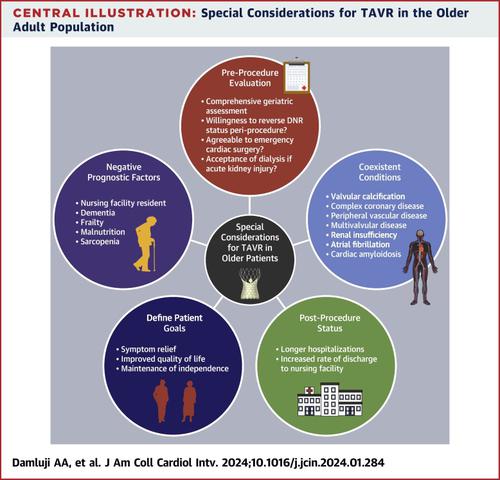当前位置:
X-MOL 学术
›
JACC Cardiovasc. Inte.
›
论文详情
Our official English website, www.x-mol.net, welcomes your
feedback! (Note: you will need to create a separate account there.)
Chronological vs Biological Age in Interventional Cardiology: A Comprehensive Approach to Care for Older Adults: JACC Family Series
JACC: Cardiovascular Interventions ( IF 11.7 ) Pub Date : 2024-04-08 , DOI: 10.1016/j.jcin.2024.01.284 Abdulla A Damluji 1 , Michael G Nanna 2 , Jennifer Rymer 3 , Ajar Kochar 4 , Angela Lowenstern 5 , Suzanne J Baron 6 , Craig R Narins 7 , Mohamad Alkhouli 8
JACC: Cardiovascular Interventions ( IF 11.7 ) Pub Date : 2024-04-08 , DOI: 10.1016/j.jcin.2024.01.284 Abdulla A Damluji 1 , Michael G Nanna 2 , Jennifer Rymer 3 , Ajar Kochar 4 , Angela Lowenstern 5 , Suzanne J Baron 6 , Craig R Narins 7 , Mohamad Alkhouli 8
Affiliation

|
Aging is the gradual decline in physical and physiological functioning leading to increased susceptibility to stressors and chronic illnesses, including cardiovascular disease. With an aging global population, in which 1 in 6 individuals will be older than 60 years by 2030, interventional cardiologists are increasingly involved in providing complex care for older individuals. Although procedural aspects remain their main clinical focus, interventionalists frequently encounter age-associated risks that influence eligibility for invasive care, decision making during the intervention, procedural adverse events, and long-term management decisions. The unprecedented growth in transcatheter interventions, especially for structural heart diseases at extremes of age, have pushed age-related risks and implications for cardiovascular care to the forefront. In this state-of-the-art review, the authors provide a comprehensive overview of the aging process as it relates to cardiovascular interventions, with special emphasis on the difference between chronological and biological aging. The authors also address key considerations to improve health outcomes for older patients during and after their invasive cardiovascular care. The role of “gerotherapeutics” in interventional cardiology, technological innovation in measuring biological aging, and the integration of patient-centered outcomes in the older adult population are also discussed.
中文翻译:

介入心脏病学中的实际年龄与生物年龄:老年人综合护理方法:JACC 家庭系列
衰老是指身体和生理功能逐渐衰退,导致对压力源和慢性疾病(包括心血管疾病)的易感性增加。随着全球人口老龄化,到 2030 年,每 6 个人中就有 1 人年龄超过 60 岁,介入心脏病专家越来越多地参与为老年人提供复杂的护理。尽管程序方面仍然是他们的主要临床焦点,但介入医生经常遇到与年龄相关的风险,这些风险会影响侵入性护理的资格、干预期间的决策、程序不良事件和长期管理决策。经导管干预措施的空前增长,尤其是针对极端年龄的结构性心脏病,已将与年龄相关的风险和对心血管护理的影响推到了最前沿。在这篇最先进的综述中,作者对与心血管干预相关的衰老过程进行了全面的概述,特别强调了时间衰老和生物衰老之间的差异。作者还阐述了在有创心血管护理期间和之后改善老年患者健康结果的关键考虑因素。还讨论了“老年治疗学”在介入心脏病学中的作用、测量生物衰老的技术创新以及在老年人群中整合以患者为中心的结果。
更新日期:2024-04-08
中文翻译:

介入心脏病学中的实际年龄与生物年龄:老年人综合护理方法:JACC 家庭系列
衰老是指身体和生理功能逐渐衰退,导致对压力源和慢性疾病(包括心血管疾病)的易感性增加。随着全球人口老龄化,到 2030 年,每 6 个人中就有 1 人年龄超过 60 岁,介入心脏病专家越来越多地参与为老年人提供复杂的护理。尽管程序方面仍然是他们的主要临床焦点,但介入医生经常遇到与年龄相关的风险,这些风险会影响侵入性护理的资格、干预期间的决策、程序不良事件和长期管理决策。经导管干预措施的空前增长,尤其是针对极端年龄的结构性心脏病,已将与年龄相关的风险和对心血管护理的影响推到了最前沿。在这篇最先进的综述中,作者对与心血管干预相关的衰老过程进行了全面的概述,特别强调了时间衰老和生物衰老之间的差异。作者还阐述了在有创心血管护理期间和之后改善老年患者健康结果的关键考虑因素。还讨论了“老年治疗学”在介入心脏病学中的作用、测量生物衰老的技术创新以及在老年人群中整合以患者为中心的结果。
















































 京公网安备 11010802027423号
京公网安备 11010802027423号